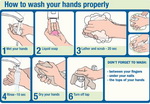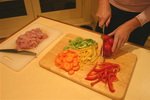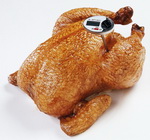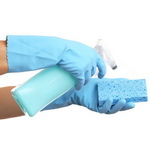|
Food Safety – Following The Rules Will Keep You HealthyWhen it comes to food safety those that provide foods to us such as farmers, ranchers, processors of raw foods and supermarkets generally do their part to provide us with food that is safe. It is up to us to continue the process once we get home from the grocery store. Food safety basics also revolve around temperature control. The difference between bacteria that can cause food to spoil and bacteria that can cause food poisoning is the temperature at which these different bacteria can survive, grow and thrive. Bacteria that spoils food grows at refrigerator temperatures below 40 degrees Fahrenheit, and these types of bacteria give food a bad look and smell; this is definitely the time to throw such food out.
Food borne illnesses such as botulism and salmonella can generally be prevented by following the four golden rules of food safety during food preparation. Those rules are: 1. Exercise cleanliness in the kitchen Following these four rules of food safety can prove to be a lifesaver. Cleanliness In The Kitchen As can be seen from the fact that food borne illness is on the rise, proper hand washing is a must, and can eliminate nearly half of all food borne illnesses. It is recommended by experts that hands should be thoroughly washed with soap and warm water for at least 20 seconds before food handling which is about how long it takes to recite the alphabet. It is especially important that hand washing take place: • Before handling food, kitchen utensils, and serving and eating food. • After handling food, especially raw meat, fish, poultry, fish and shellfish, and eggs. • Between kitchen tasks such as cutting up meat, fish and poultry and preparing for example a salad.
• After using the bathroom, blowing your nose, changing a baby’s diaper, touching pets, handling garbage, dirty dishes, dirty laundry, and using the telephone, because all of these activities are a hive of bacteria that can easily be transmitted to food and into humans that consume the food and on to the production of food borne illness. • If there are any kinds of cuts, rashes, or infections on the skin, especially the hands protective plastic or rubber gloves should be worn. • When sneezing or coughing during food preparation the head should be turned away from the food and the mouth and nose covered with a tissue, and hands washed immediately afterwards. Cleaning The Food Preparation Area • After contact with raw meat, poultry, fish or seafood all utensils used should be thoroughly washed with hot soapy water and dried thoroughly. • After working with raw meat, poultry, and fish and seafood use paper towels and for immediate cleanup as well.
• After contact with raw meat, poultry, fish or seafood all work surfaces and countertops should be thoroughly washed with hot soapy water or an antibacterial cleaner and dried thoroughly. • Both the surfaces of the refrigerator and the meat and vegetable drawers of the inside of the refrigerator should be cleaned often with hot soapy water. • Perishable foods should be reviewed each week and any foods that are expired should be thrown out. • Dish cloths and sponges should be washed frequently in hot soapy water and sanitized periodically with a bleach/water mixture that is ¾ cup of bleach to 4 quarts (1 gallon) of water. • Pets should never be allowed in the kitchen during food preparation. Cutting Board Usage Cutting boards should definitely be used for cutting up raw meat or preparing vegetables. These cutting boards are generally wood, plastic or glass and you should have two separate cutting boards. • Wooden cutting boards should not be used for cutting raw meat, poultry, fish or seafood since they are porous, and are better for vegetables, fruits, bread and nuts. • Hard plastic, glass or silicone cutting boards are better for cutting up raw meat, poultry, fish or seafood.
For some great sections on food safety some great references are: • The Taste of Home Cookbook – All New Edition from Taste of Home Books, Reiman Media Group • The All New Good Housekeeping Cook Book, Edited by Susan Westmoreland, Hearst Books, New York • Betty Crocker Cookbook – New Edition, by Wiley Publishing, Inc.
Cooking Basics
|
Food Safety Basics
Proper Handwashing Is Key

Use Separate Cutting Boards

Monitor Refrigerator Temperature

Monitor Food Temperature

Thoroughly Clean After Prep And Cooking






